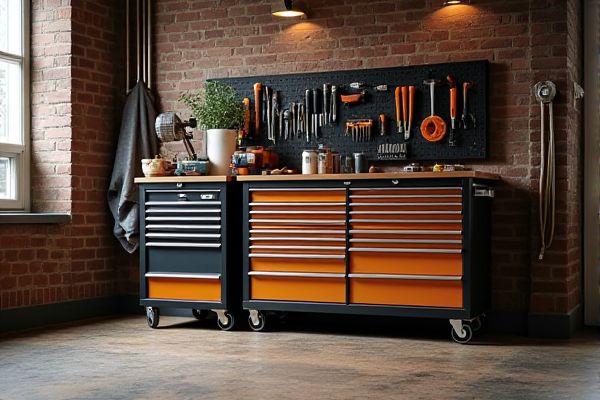
Tool chests are portable storage units ideal for organizing hand tools with multiple drawers, while tool cabinets are larger, often stationary, and provide more extensive storage options for power tools and bulky equipment. Discover which option best suits Your workspace needs by reading the full article.
Table of Comparison
| Feature | Tool Chest | Tool Cabinet |
|---|---|---|
| Design | Stacked drawers, portable top chest, often sits on a base cabinet | Large storage unit with multiple drawers, usually stationary |
| Portability | Highly portable, lightweight, easy to carry | Generally stationary, heavy, less portable |
| Storage Capacity | Moderate, suitable for small to medium tools | High, accommodates larger and more tools |
| Material | Metal or durable plastic | Mostly metal, heavy-duty construction |
| Use Case | Ideal for quick access and on-the-go jobs | Best for workshop or garage storage |
| Price Range | Affordable to mid-range | Mid-range to expensive |
Introduction to Tool Chests and Tool Cabinets
Tool chests are portable storage units with multiple drawers designed for organizing hand tools and small parts, often featuring a top compartment and a durable, compact frame ideal for mobility. Tool cabinets, larger and typically stationary, offer greater storage capacity with deeper drawers and more robust construction, suitable for housing bulkier tools and equipment in workshops or garages. Both types serve essential roles in maintaining tool organization, but the choice depends on storage needs, workspace size, and portability requirements.
Key Differences Between Tool Chests and Tool Cabinets
Tool chests feature a stackable design with multiple drawers that offer easy access and portability, making them ideal for organizing hand tools and smaller items. Tool cabinets are larger, often stationary units with more extensive storage capacity, including shelves and compartments suited for storing power tools and bulky equipment. The primary differences lie in mobility, storage capacity, and the intended use environment, with tool chests favoring compact, mobile tool management and tool cabinets supporting comprehensive, stationary workshop organization.
Storage Capacity Comparison
Tool chests typically offer portable storage with multiple smaller drawers designed for organizing hand tools, making them ideal for tasks that require mobility. Tool cabinets provide larger storage capacity with deeper compartments and more robust construction, suitable for storing bulkier tools and heavy equipment in a fixed location. Your choice depends on whether you prioritize mobility and compartmentalization or maximum storage volume and durability.
Mobility and Portability Features
Tool chests offer enhanced mobility with built-in wheels and handles, making them ideal for frequent movement across job sites. Tool cabinets tend to be larger and heavier, often designed as stationary storage solutions with limited portability. For professionals requiring easy transport and flexible workspace setup, tool chests provide superior portability features compared to fixed tool cabinets.
Durability and Construction Materials
Tool chests typically feature heavy-duty steel construction with reinforced corners and thick drawers, ensuring exceptional durability for tough workshop environments. Tool cabinets often utilize similar materials but may include additional design elements like powder-coated finishes and caster wheels for mobility without compromising structural integrity. Both options are designed to withstand heavy use, but tool chests generally offer a more robust build geared towards prolonged durability.
Security and Locking Mechanisms
Tool chests typically feature robust locking mechanisms such as central locks or key locks that secure multiple drawers simultaneously, enhancing theft protection. Tool cabinets often incorporate advanced security features like combination locks, electronic keypads, or reinforced steel doors designed for heavy-duty security in industrial settings. Both storage solutions prioritize securing tools, but tool cabinets generally offer higher-level locking options suitable for environments requiring stringent access control.
Organization and Accessibility
A tool chest offers compact organization with multiple stacked drawers that provide easy access to frequently used tools, making it ideal for quick retrieval. A tool cabinet, on the other hand, typically features a larger storage space with shelves or deeper compartments, suited for organizing bulkier tools and equipment while maintaining accessibility. Your choice depends on whether you prioritize portability and drawer-based organization or spacious, vertical storage for enhanced tool accessibility.
Suitability for Home vs. Professional Use
Tool chests offer compact designs with portability, making them ideal for home use and small projects requiring easy mobility. Tool cabinets provide larger storage capacity with durable construction, suitable for professional workshops needing organized, heavy-duty tool management. Choosing between them depends on the frequency of use, space availability, and the scale of the tasks involved.
Price and Value Considerations
Tool chests generally offer higher portability and compact storage at a lower price point, making them ideal for users who need mobility and affordability. Tool cabinets, though typically more expensive, provide greater storage capacity and durability, delivering better long-term value for those with extensive tool collections. Your choice should balance budget constraints with storage needs to maximize overall investment effectiveness.
Choosing the Right Storage Solution for Your Needs
Selecting between a tool chest and a tool cabinet depends on your workspace size and tool organization preferences. Tool chests offer portability with multiple drawers ideal for smaller tool collections, while tool cabinets provide larger storage capacity and often feature side compartments for bulky items. Assess your tool inventory and mobility requirements to choose the ideal storage that enhances efficiency and accessibility.
 homyna.com
homyna.com